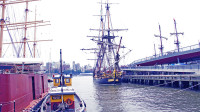
From left to right — masts of the Peking, l’Hermione and the masts of El Galeon
Last week provided a rare opportunity to glimpse over 400 years of sailing ship history in three ships, tied up almost side by side, at New York’s South Street Seaport. Berthed on the south side of Pier 15, El Galeon Andalucia is a replica of a 16th century Spanish galleon. On the north side of the pier was l’Hermione, a replica of an 18th century French Concorde class frigate. On Pier 17, the four-masted barque Peking, built in 1911, represents the culmination of sailing technology, before the world’s commercial sailing fleet was finally pushed aside by steam and motor ships.
What I find fascinating about the three ships is that while their designs are separated by centuries, the DNA of each is easily identifiable in the others. In some respects, the three ships bracket the great European Age of Sail.
Galleons, and carracks before them, were the ships that first crossed oceans and rounded the globe. On one hand, they were the ships of the “Great Age of the Discovery.” On the other, they were also the plague ships that brought European diseases that wiped out millions of Native Americans. For good or ill, they were ships that wholly transformed civilization.
Looking at the galleon and the frigate, the similarities are clear. l’Hermione‘s quarterdeck and fo’c’s’le are lower than the dramatic bow and stern decks on El Galeon, yet there is still a familial resemblance. l’Hermione also has a beakhead, though much less pronounced than El Galeon, which almost appears to be a ram or boarding platform.
The two ships are similar in size, although the 18th century frigate was one of the smaller warships of her period while the galleon was often one of the larger of the 16th century. Unlike older Northern European ships, such as the Hansa cog, carracks and galleons featured mizzen masts with fore-and-aft sails to assist in steering. They also carried fore masts and multipart-masts which could carry topsails, above the mainsail.
The rig on the l’Hermione is similar, reflecting two hundred years of refinement of the older rig. The lateen mast on the mizzen has been cut down to a gaff spanker. In addition to topsails on the top masts, l‘Hermione also carries t’gallant sails set on a t’gallant mast above the top mast. While still carrying a sprit-sail below the bow sprit, jibs on l’Hermione have replaced the sprit-topsail on El Galeon.
Of the three ships, Peking reflects the greatest changes in technology. The real break-through was in materials. Wooden ships were limited in how large they could be built without facing problems of hogging and flexing in a seaway. The Peking is built of steel, which is about 20 times stiffer than wood. Peking is roughly twice as long as l’Hermione, at least three time the volumetric tonnage, and has four masts rather than three. Where l’Hermione sets three sails on her main and foremasts — a course, topsail and t’gallant, the Peking sets six — a course, upper and lower topsails, upper and lower t’gallants and a royal sail. The Peking sets roughly twice the sail area as l’Hermione.
The one significant difference in arrangements between Peking and the older designs is the so called “Liverpool House,” the raised deck amidships that served as crew quarters and provided additional buoyancy and protection in heavy seas. The Liverpool house appeared on sailing ships around the turn of the 20th century. A similar arrangement was also adopted on early “three island” steamships.
As different as each of these ships may be, they are clearly at least distant cousins. I feel fortunate to have seen three such different and yet intrinsically connected ships — almost the entire history of sail — literally only a few few hundred feet apart.

Pingback: Travel News / Four Hundred Years of Sailing Ships at the South Street Seaport
I’m very glad you used the full name of Andalucía. She is frequently berthed in St. Augustine (a bit over three hours from me) and there she’s universally referred to as simply “El Galeón”. Actually she is usually called “the Spanish galleon, ‘El Galeón'” which I find weirdly redundant.
Nice post! I spent much of this past Friday morning waiting in line at South Street Seaport, waiting to go aboard L’Hermione. During that time, I enjoyed similar reflections on the evolution of ship design. Fortunately, the guy behind me in line was interested and kept asking questions. It was a great day for us boat geeks!
Fascinating!
At Philadelphia’s Tall Ship Festival, in addition to the variety of ships on-hand, which included schooners Lynx and Pride of Baltimore 2 representing 19th century ships, we only had to turn our heads a little to see the docked windjammer Moshulu, one of the last working sailing ships of the 20th century. It was great to see so many people interested in seeing for themselves these wonderful sailing ships of yesteryear!
Time and schedules have prohibited my own visit to the piers. Thanks for describing the distinctions of these three special ships!